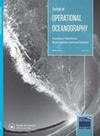Calibration of a marine floating litter transport model
IF 2.4
3区 地球科学
Q4 METEOROLOGY & ATMOSPHERIC SCIENCES
引用次数: 21
Abstract
ABSTRACT Predicting the transport of marine floating litter requires a detailed understanding of the processes involved in the dispersion of floating materials in the ocean. The restraining effect of a near-coastal boundary or shallow bottom topography may affect the drift response to local wind forcing. The aim of this work is to develop a particle-tracking model for the north-west Iberian waters that allows for spatial variations in the effect of winds on the transport of marine floating litter. Observational data from 23 drifters were used, in conjunction with wind and ocean current data from atmospheric and ocean models. The drifter locations were grouped into three separate zones based on the bathymetry and the orientation of the coastline. Response matrices for each of these areas were computed using a 2-D vector regression approach. The maximum drift response to local wind forcing is alongshore in inner shelf waters, whereas an isotropic drift response to winds is observed in outer shelf waters. The wind drag coefficient ranges from 0.5 × 10−2 to 1.2 × 10−2, depending both on the wind direction and the drifter position.海洋漂浮垃圾运输模型的校正
预测海洋漂浮垃圾的运输需要对海洋中漂浮物质分散的过程有详细的了解。近海岸边界或浅底地形的抑制作用可能影响局地风强迫的漂移响应。这项工作的目的是为伊比利亚西北部水域开发一个粒子跟踪模型,该模型允许风对海洋漂浮垃圾运输影响的空间变化。研究使用了23艘漂流船的观测数据,以及大气和海洋模型的风和洋流数据。根据水深测量和海岸线的方向,漂浮物的位置被分为三个独立的区域。使用二维向量回归方法计算每个这些区域的响应矩阵。对局地风强迫的最大漂移响应是在大陆架内部水域的沿岸,而在大陆架外部水域观察到对风的各向同性漂移响应。风阻系数随风向和漂船位置的变化在0.5 × 10−2 ~ 1.2 × 10−2之间。
本文章由计算机程序翻译,如有差异,请以英文原文为准。
求助全文
约1分钟内获得全文
求助全文
来源期刊
CiteScore
7.50
自引率
9.70%
发文量
8
审稿时长
>12 weeks
期刊介绍:
The Journal of Operational Oceanography will publish papers which examine the role of oceanography in contributing to the fields of: Numerical Weather Prediction; Development of Climatologies; Implications of Ocean Change; Ocean and Climate Forecasting; Ocean Observing Technologies; Eutrophication; Climate Assessment; Shoreline Change; Marine and Sea State Prediction; Model Development and Validation; Coastal Flooding; Reducing Public Health Risks; Short-Range Ocean Forecasting; Forces on Structures; Ocean Policy; Protecting and Restoring Ecosystem health; Controlling and Mitigating Natural Hazards; Safe and Efficient Marine Operations

 求助内容:
求助内容: 应助结果提醒方式:
应助结果提醒方式:


